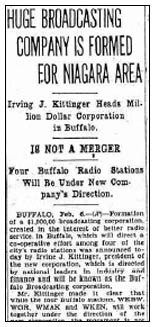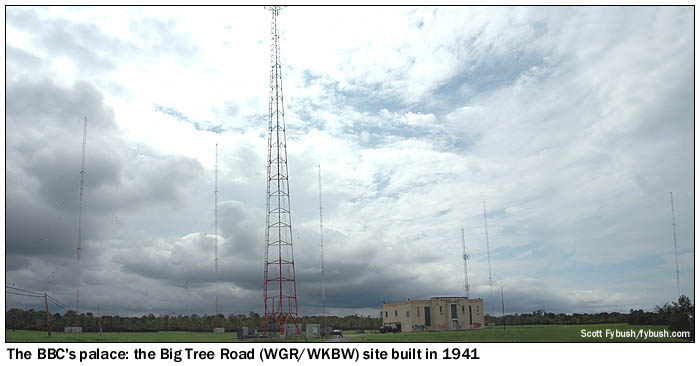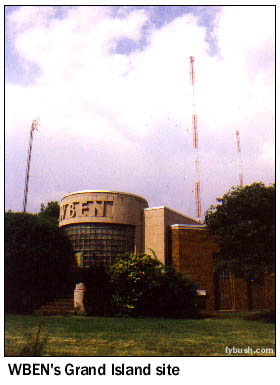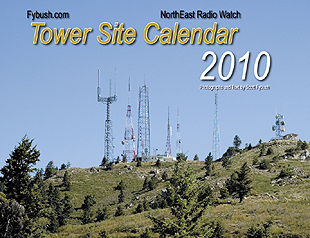
|
|

February 26, 2010
Remembering Buffalo's BBC
/wmak-bldg.jpg) |
/wmak-wide.jpg) |
Two years ago in this space, we presented what was then a new (at least to us) discovery: one of the oldest transmitter sites still standing, just an hour or so from our own home base in western New York.
But when we put up the piece about the old WMAK/WBL site in Wheatfield, New York back in February 2008, there was a lot we still didn't know about its history - and so it's well worth another visit to recount what turns out to be an even more interesting story than we realized at first.
/wmak-big.jpg) Here's
what we had to say in 2008:
Here's
what we had to say in 2008:
Every once in a while, an interesting piece of broadcast history will be found sitting in plain sight - and every once in a very long while, that interesting piece of broadcast history is just an hour or so away from our home base here in western New York.
We credit Jim Travis, chief engineer for the Family Life Network, for unearthing this week's featured site, which hasn't seen broadcast use since at least 1940.
Jim drove by this site at 7263 Shawnee Road in North Tonawanda, north of Buffalo (actually, it's just over the line in the town of Wheatfield), a month or so ago and wondered what these two self-supporting towers were doing in an area that's rapidly being developed into residential subdivisions. He asked former upstate engineer (and broadcast engineer) Mark Humphrey, who began to uncover the fascinating history behind these towers and the building that sits between them.
What Mark found first was a website describing the history of marine shortwave/VHF station WBL, which operated from out here on Shawnee Road from the early 1940s until sometime in the early eighties, first under RCA ownership and later in private hands. (It turns out that one of the operators at WBL in the seventies was Dan Gurzynski, who'd later go on to be an engineer at the Entercom stations in Buffalo.)
But before these towers belonged to WBL, they served as the transmitter site for one of the Buffalo area's first radio stations. WMAK came on the air in Lockport, 10 miles north of this site, in 1922. It soon moved from little Lockport to much bigger Buffalo, where engineer I.R. "Ike" Lounsberry set up studios in the Hotel Lafayette, making WMAK (by then a charter CBS affiliate) the first of several broadcasters who would call that building home.
In 1927, Lounsberry moved WMAK's transmitter from the Norton Laboratories on Mill Street in Lockport to this Shawnee Road location, erecting these towers and the building between them.
So far, so good - but there's actually much more to be said about what happened next. When we put these pictures up in 2008, I knew part of the story: after just three years on Shawnee Road, WMAK left its 900 kilocycle frequency, this site was sold to the Buffalo Evening News, and the frequency became the home to a new station, WBEN, which would remain here for more than a decade before moving to its current transmitter site on Grand Island in 1941.
What I didn't know was exactly why WBEN never chose to acknowledge its early roots as WMAK, but with the help of some further research, aided immensely by David Gleason's scans of 1920s-era RADEX directories at americanradiohistory.com and by the FCC's scans of early Radio Service Bulletins, the rest of the story now comes into focus:
 In 2008,
I alluded in passing to Lounsberry's role in establishing the
Buffalo Broadcasting Corporation, noting that the BBC at one
point controlled WGR, WKBW, WMAK and WKEN. It's worth taking
a look at each of these stations:
In 2008,
I alluded in passing to Lounsberry's role in establishing the
Buffalo Broadcasting Corporation, noting that the BBC at one
point controlled WGR, WKBW, WMAK and WKEN. It's worth taking
a look at each of these stations:
WGR's pioneering role in Buffalo radio is unchallenged. While it wasn't the first station in town (that was the very short-lived WWT, which came and went in 1922), WGR's debut on May 22, 1922 makes it the oldest surviving station in Buffalo. It came on the air from the Federal Telephone & Telegraph Co. building on Elmwood Avenue (the building still stands, home to the FWS furniture store), and soon settled in on 990 kilocycles.
WKBW was founded in 1926 by the Rev. Clinton Churchill, transmitting on 1380 kilocycles from his Churchill Tabernacle at 1420 Main Street in Buffalo at first, and soon moving to a site on what's now Sweet Home Road in Amherst, near where present-day I-990 cuts across en route to the SUNY Buffalo north campus.
WMAK's early history has already been noted; it operated on 550 kilocycles from Lockport, and remained on that frequency for its first year at Shawnee Road.
WKEN is perhaps the most mysterious of the four stations. It was on the air at 1470 kilocycles by 1927, and perhaps somewhat earlier, broadcasting initially from Kenmore, just north of Buffalo (hence the callsign), then from nearby Grand Island at a location I've yet to unearth. The "General Order 40" realignment of the broadcast spectrum, which took effect November 11, 1928, initially proposed to keep WKEN on 1470, imposing a share-time arrangement with WKBW on the same channel. WKEN proposed an alternate arrangement, becoming one of the first daytime-only stations on a different channel, 1040, and leaving 1470 for WKBW's full-time use.
(General Order 40 also moved WGR to WMAK's former 550 kilocycle frequency, shifting WMAK to 900 kilocycles.)
By early 1929, some of these stations were already cooperating; WGR and WKBW were apparently sharing the Sweet Home Road transmitter site, for instance. On February 6, the newspapers carried word of a big development: the formation of a "$1,000,000 broadcasting corporation, created in the interest of better radio service in Buffalo." This was the BBC, with furniture magnate Irvine Kittinger as president and a leadership group that included WMAK's Lounsberry, WKBW's Churchill and Marine Bank's George Rand, who provided studio space for all four stations in the new Rand Building on Lafayette Square, then Buffalo's tallest structure.
Even under the relatively lax regulations of 1929, four stations under common management raised eyebrows, and the news stories announcing the formation of the BBC made it clear that "the movement is not in any sense a merger."
Within a few months, the News was preparing to launch its own radio station, and by January 1930 it had been granted a license for WRAS, operating from Orchard Park, south of Buffalo, on 900 kilocycles. Here we enter a gray area in my research thus far: 900 kilocycles was the frequency WMAK was already using up in Wheatfield, and it's not immediately clear whether the Federal Radio Commission intended for WMAK and WRAS to share time, or whether the News intended to bump WMAK off the air entirely.
This much I do know: by late June of 1930, WMAK was gone from 900 and from the Shawnee Road site in Wheatfield. The frequency became home to the News station, under new calls WBEN. But WMAK didn't go away at that point. Instead, the BBC moved the WMAK call letters up the dial to that daytimer on 1040 broadcasting from Grand Island, the former WKEN - and that, the continued existence of a BBC station called "WMAK," now clearly explains why WBEN never acknowledged the earlier history of its frequency or its first transmitter site.
The second incarnation of WMAK didn't last long, and there lies another mystery: by 1932, the 1040 frequency was silent in Buffalo and the WMAK calls were gone for good. (They'd later have another run at fame down in Nashville, but that's a different story!)
Down to a mere two stations, the BBC was far from out: WGR and WKBW (which shifted again to 1480 kc at some point in the thirties) remained powerful players in Buffalo, competing intensely with WBEN, which itself added a second signal in 1936 with the purchase of another pioneering station, WEBR (then operating at 1310 kc, and later to 1340 after NARBA).

In 1940, WKBW received FCC approval for a power increase to 50,000 watts, and the BBC began building a new joint transmitter site for WKBW and WGR to the south of Buffalo, on Big Tree Road in Hamburg. (We profiled that site in August 2007.) That facility opened for business Oct. 10, 1941, just a few months after the NARBA realignment moved WKBW to 1520, and just a month after WBEN (itself shifted to 930 on the dial by NARBA) opened its own new transmitter site on Grand Island, which we also profiled in August 2007.
 By
then, the days of duopoly radio in Buffalo were numbered: the
FCC's "Report on Chain Broadcasting" in 1942 established
a new policy limiting owners to just one station in a market,
forcing both the BBC and the News to shed one of their
two stations. The News sold WEBR to its competitor, the
Courier-Express, and Churchill retook control of WKBW.
(WKBW also took sole ownership of the Hamburg transmitter site,
which WGR continued to share as a tenant.)
By
then, the days of duopoly radio in Buffalo were numbered: the
FCC's "Report on Chain Broadcasting" in 1942 established
a new policy limiting owners to just one station in a market,
forcing both the BBC and the News to shed one of their
two stations. The News sold WEBR to its competitor, the
Courier-Express, and Churchill retook control of WKBW.
(WKBW also took sole ownership of the Hamburg transmitter site,
which WGR continued to share as a tenant.)
What followed for the next half-century was some of the most spirited radio competition in any medium-sized market: WGR was eventually bought by the group that launched channel 2 in 1954, which came to be known as Transcontinent; it and successor Taft made WGR into an important full-service voice for the city in a fierce rivalry with WBEN, which remained under News ownership into the seventies. After World War II, WEBR moved from 1340 to a 5000-watt (albeit highly directional) signal on 970, transmitting from a new five-tower array just a few miles from the WGR/WKBW site in Hamburg. After finding success as an all-news station, it was bought by public broadcaster WNED in the seventies, becoming one of the first AM news-talk voices in public radio. And WKBW, of course, used its big 50,000-watt signal to become one of the first major top-40 AM voices in the late fifties and remained a legendary music station into the eighties.
Along the way, the Buffalo dial sprouted still more signals, and at some point we'll take some space here to chronicle the stories of WBNY, WXRA, WUFO, WYSL, WWOL, WNIA and the others that arrived on the Queen City dial after the war.
But we'll close this week's saga with the irony of consolidation: in the mid-nineties, Keymarket Communications bought both WBEN and WKBW (which had by then changed calls to WWKB), and in 1996 Keymarket's successor, Sinclair, bought WGR - and just like that, the three big signals that had been at the core of the BBC back in 1929 were back under the same roof, albeit not that of the Rand Building!
(The Rand Building did remain an important piece of Buffalo radio history; after WGR moved out in the early fifties, other floors of the building eventually became home to the studios and transmitters of several FM stations. Today, the Rand serves as home to Regent's four-FM cluster.)
 One
more note: don't miss your chance to grab one of the dwindling
remaining stash of the all-new Tower
Site Calendar 2010, just in time to fill that
space on the wall where your 2009 edition once hung.
One
more note: don't miss your chance to grab one of the dwindling
remaining stash of the all-new Tower
Site Calendar 2010, just in time to fill that
space on the wall where your 2009 edition once hung.
(It's more than just pretty pictures and dates - the modest sum we raise from each year's calendar helps make possible the travel needed to make this feature happen every week on the website...and we're grateful for all your support!)
- Previous Site of the Week: Carlisle, PA
- Next Week: State College, PA
- Site of the Week INDEX!
- How can you help support Site of the Week? Click here!
- Submit your suggestions for a future Site of the Week!
